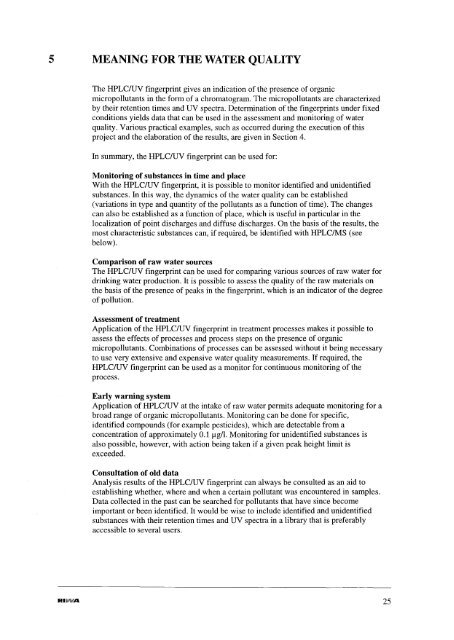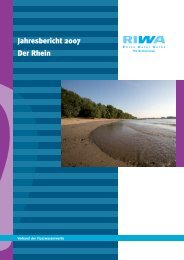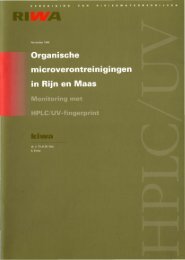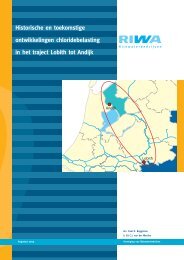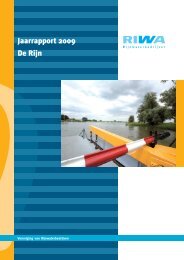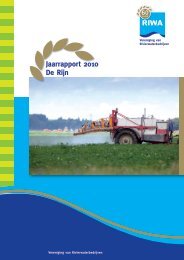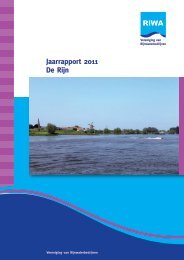Organic micropollutants in Rhine and Meuse a - Riwa
Organic micropollutants in Rhine and Meuse a - Riwa
Organic micropollutants in Rhine and Meuse a - Riwa
You also want an ePaper? Increase the reach of your titles
YUMPU automatically turns print PDFs into web optimized ePapers that Google loves.
5<br />
MEANING FOR THE WATER QUALITY<br />
The HPLC/uV f<strong>in</strong>gerpr<strong>in</strong>t gives an <strong>in</strong>dication of the presence of organic<br />
<strong>micropollutants</strong> <strong>in</strong> the form of a chromatogram. The <strong>micropollutants</strong> are characterized<br />
by their retention times <strong>and</strong> UV spectra. Determ<strong>in</strong>ation of the f<strong>in</strong>gerpr<strong>in</strong>ts under fixed<br />
conditions yields data that can be used <strong>in</strong> the assessment <strong>and</strong> monitor<strong>in</strong>g of water<br />
quality. Various practical examples, such as occurred dur<strong>in</strong>g the execution of this<br />
project <strong>and</strong> the elaboration of the results, are given <strong>in</strong> Section 4.<br />
In summary, the HPLC/UV f<strong>in</strong>gerpr<strong>in</strong>t can be used for:<br />
Monitor<strong>in</strong>g of substances <strong>in</strong> time <strong>and</strong> place<br />
With the HPLC/UV f<strong>in</strong>gerpr<strong>in</strong>t, it is possible to monitor identified <strong>and</strong> unidentified<br />
substances. In this way, the dynamics of the water quality can be established<br />
(variations <strong>in</strong> type <strong>and</strong> quantity of the pollutants as a function of time). The changes<br />
can also be established as a function of place, which is useful <strong>in</strong> particular <strong>in</strong> the<br />
localization of po<strong>in</strong>t discharges <strong>and</strong> diffuse discharges. On the basis of the results, the<br />
most characteristic substances can, if required, be identified with HPLC/MS (see<br />
below).<br />
Comparison of raw water sources<br />
The HPLC/uV f<strong>in</strong>gerpr<strong>in</strong>t can be used for compar<strong>in</strong>g various sources of raw water for<br />
dr<strong>in</strong>k<strong>in</strong>g water production. It is possible to assess the quality of the raw materials on<br />
the basis of the presence of peaks <strong>in</strong> the f<strong>in</strong>gerpr<strong>in</strong>t, which is an <strong>in</strong>dicator of the degree<br />
of pollution.<br />
Assessment of treatment<br />
Application of the HPLC/UV f<strong>in</strong>gerpr<strong>in</strong>t <strong>in</strong> treatment processes makes it possible to<br />
assess the effects of processes <strong>and</strong> process steps on the presence of organic<br />
<strong>micropollutants</strong>. Comb<strong>in</strong>ations of processes can be assessed without it be<strong>in</strong>g necessary<br />
to use very extensive <strong>and</strong> expensive water quality measurements. If required, the<br />
HPLC/uV f<strong>in</strong>gerpr<strong>in</strong>t can be used as a monitor for cont<strong>in</strong>uous monitor<strong>in</strong>g of the<br />
process.<br />
Early warn<strong>in</strong>g system<br />
Application of HPLC/UV at the <strong>in</strong>take of raw water permits adequate monitor<strong>in</strong>g for a<br />
broad range of organic <strong>micropollutants</strong>. Monitor<strong>in</strong>g can be done for specific,<br />
identified compounds (for example pesticides), which are detectable from a<br />
concentration of approximately 0.1 f.lg/l. Monitor<strong>in</strong>g for unidentified substances is<br />
also possible, however, with action be<strong>in</strong>g taken if a given peak height limit is<br />
exceeded.<br />
Consultation of old data<br />
Analysis results of the HPLC/UV f<strong>in</strong>gerpr<strong>in</strong>t can always be consulted as an aid to<br />
establish<strong>in</strong>g whether, where <strong>and</strong> when a certa<strong>in</strong> pollutant was encountered <strong>in</strong> samples.<br />
Data collected <strong>in</strong> the past can be searched for pollutants that have s<strong>in</strong>ce become<br />
important or been identified. It would be wise to <strong>in</strong>clude identified <strong>and</strong> unidentified<br />
substances with their retention times <strong>and</strong> UV spectra <strong>in</strong> a library that is preferably<br />
accessible to several users.<br />
RIMfA<br />
25


